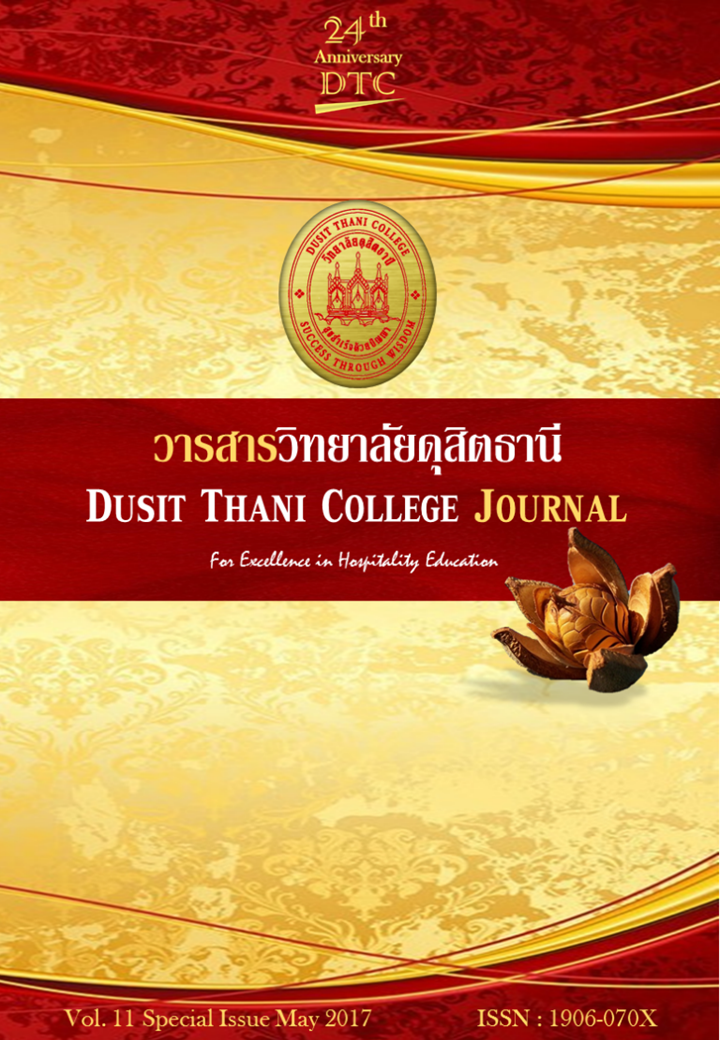The Role of Local Cuisines in Creative Tourism Process: A Case Study of Lao Khrang Ethnic Group in Chai Nat Province
Main Article Content
Abstract
This paper aims to 1) study local food wisdom and 2) develop creative tourism activities for community tourism. The paper use a qualitative method with the triangulation approach to analyze. The primary data were obtained from all involved stakeholders, such as local people, leader, authorities, and related government agencies, by conducting observation participation, in-depth interview, focus group discussion, and group interview to identify local food wisdom and current tourism activities within the case study area. The documentary research was also conducted from different sources and related empirical studies.
The findings indicate that Lao Khrang ethnic group in Chai Nat has been preserving its symbolic foods, such as Pla ra (Fermented fish), Pla-Dook Tom Pla ra (Catfish in fermented fish soup), Jaew Kai (Minced chicken spicy sauce), and Kanom Dak Kao Pod (Steamed sweet corn wrapped with banana leaf or corn leaf). This study has emphasized on the use of symbolic foods through creative tourism process in relation to conservation, rehabilitation, adaptation, and creation, in creating new creative tourist activities for community tourism promotion. Finally, the study has proposed the possible cooking activities for Lao Khrang ethnic group in Chai Nat based on the creative tourism concept.
Article Details
Article Screening Policy
- All research and academic articles to be published must be considered and screened by three peer reviews in the relevant field / article.
- All articles, texts, illustrations and tables published in the journal are the personal opinions of the authors. Editors don't always have to agree. And no responsibility whatsoever is the sole responsibility of the author.
- The articles to be published must never be published. Where did you first publish? And not in the consideration of other journals If the audit found that there has been a duplicate publication It is the sole responsibility of the author.
- Any article that the reader sees as being plagiarized or impersonated without reference. Or mislead the work of the author Please let the journal editor know it will be your greatest blessing.
References
Chamarik, Sane. (1991). The guidelines for Thai Education Development: The preliminary analysis.
Choibamroong, Therdchai. (2014). Locale Wisdom for Local Creative Tourism Development. Nonthaburi: King Prajadhipok's Institute Publication.
Cohen, E., & Avieli, N. (2010). Food tourism : Attraction and impediment. Annals of Tourism Research, 31(4), 755-778.
Dachum, Puriwaj. (2013). Creative Tourism Development: from Concepts to Practice for Thailand. Bangkok: Silpakorn University Journal (Thai Version)
HALL, C.M., and MITCHELL, R. (2000), We are what we eat: Food, tourism and globalization,
Tourism Culture and Communication, 2, 29-37.
HALL, C.M., and SHARPLES, L. (2003), The consumption of experiences or the experience of
consumption? An introduction to the tourism of taste, in C.M. Hall, L. Sharples, R.
Hussain, Z., Lema, J., & Agrusa J. (2012). Enhancing the cultural tourism experience through gastronomy in the Maldives. Journal of Tourism Challenges and Trends, v(2), 71-84.
Matei, F. (2015). Cultural tourism potential, as part of rural tourism development in the north-east of Romania. Procedia Economics and Finance, 453-460. doi:10.1016/S2212-5671(15)00584-5
OECD. (2014). Tourism and the Creative Economy, OECD Studies on Tourism, OECD Publishing. Retrieve from https://dx.doi.org/10.1787/9789264207875-en
Richards, G. (2010). Creative Tourism and Local Development. In Wurzburger, R, et al. Creative Tourism: A Global Conversation: How to Provide Unique Creative Experiences for Travelers Worldwide. Santa Fe: Sunstone Press.
Raymond. C. (2010). What’s in a Name? The Origins of the Term ‘Creative Tourism’. In Wurzburger, R, et al. Creative Tourism: A Global Conversation: How to Provide Unique Creative Experiences for Travelers Worldwide. Santa Fe: Sunstone Press.
Richards, G., & Marques, L. (2012). Exploring creative tourism: Editors introduction. Journal of Tourism Consumption and Practice, 4(2).
Scarpato, R. (2002), Gastronomy as a tourist product: The perspective of gastronomy studies, in A.M. Hjalager and G. Richards (eds.), Tourism and gastronomy. London: Routledge.
Thawornpat, Mayuree., & Chawsuan, Em-orn. (2005). Encyclopedia of ethnic groups in Thailand. Bangkok: Ek Pimthai Company Limited.
Tourism Authority of Thailand Suphanburi Office. (2013). The cultural community, Lao Krang Ban Kut Jok and Eakkaraj Drum Village Locate in Pamoke, Angthong have received The 9th Thailand Tourism Awards 2013. Retrieve from https://www.tatsuphan.net/Snews01.html
Wasi, Prawet. (1987). The Creativity of Thai Local Wisdom for Development. Bangkok: Journal of Community Development
Wisudthiluck, Suddan. (2011). Creative Tourism Thailand. Scholarship awarded from Designated Areas for Sustainable Tourism Administration (Public Organization).
Wurzburger, R, et al. (2010). Creative Tourism: A Global Conversation : How to Provide Unique Creative Experiences for Travelers Worldwide. Santa Fe: Sunstone Press.
Viravaidya, Vina. (1992). The selection of food consumption choices of Thai people. Journal of Nutrition Association.
United Nation Educational, Scientific and Cultural Organization (UNESCO). (2008) The 2008 Santa
Fe UNESCO International Conference on Creative Tourism in Santa Fe. Santa Fe . New Mexico. n.p.


